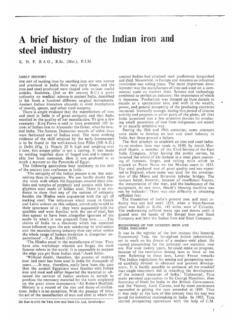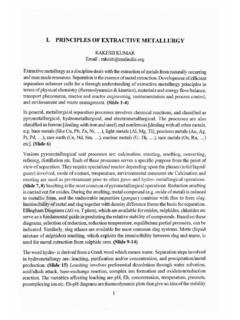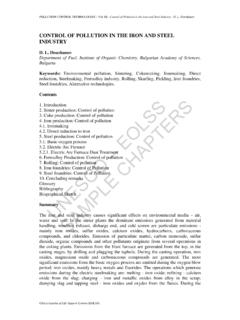Transcription of Production Smelting Technologies for Ferrochromium
1 FerroAlloyIndustries in the LiberalisedEconomyEditors : Vaish, Singh, N. G. Goswvarni and P. RamachandraraoO NML Jamshedpur 831007, 1997, pp. 3750 Smelting Technologies for FerrochromiumProduction- Recent GOELN ational Metallurgical Laboratory, Jamshedpur - 831 007, IndiaABSTRACTThe conventional process for producing high carbon Ferrochromium bysmelting chromite ore in a submerged arc furnace is reviewed and itslimitations highlighted with regard to (a) product quality through impurityremoval, and (b)highpower consumption for a given raw materialssupply. The trends towards (i) utilization of medium grade ore fines byagglomeration, and (ii) pre-reduction of chromite ore prior to arc smeltingare examinedinterms of their effectivenessinaccomplishing substantialsavings in power consumption.
2 A technoeconomic evaluation of theconventional Smelting practice in the Indian context makes obvious theneed for adopting improved Technologies for better cost-competitivenessand survival inthisera of economic : Ferro chromium, Smelting , Submerged arc than 80% of the world Production of ferrochromiumis used in stainlesssteelmaking. There are four grades of Ferrochromium produced commercially,characterized broadly in terms of their carbon and chromium contentsHigh carbon Ferrochromium (Cr :>60%,C :6-9%)Charge chrome(Cr :50-60%,C :6-9%)Medium carbon Ferrochromium (Cr :56-70%,C :1-4%) andLow carbonferrochromium(Cr56-70%,C )The demand for low-carbon Ferrochromium , produced by reacting Fe-Cr-Sialloy with a Cr2O3 CaO based slag, has decreased dramatically during the last twodecades mainly due to the commercial development of AOD and VOD processeswhich allow removal of carbon fromstainlesssteels with acceptable loss ( GOELti on) of chromium"'.
3 These low and ultra-low carbon Ferrochromium grades areused mainly for final adjustments of composition and for super alloys which aremelted in coreless induction furnaces. The ultra-low Ferrochromium , producedby a]uminothermic reduction of chrornite, is relatively pure but very expensiveand consequently, not widely employed in the steel a result the high-carbon Ferrochromium has become the most widelyproduced and consumed grade of chromium-containing ferroalloys. The produc-tion of high carbon ferrrochromium is based on reduction Smelting of chromiteore with coke in the presence of silica in a submerged arc this paper the performance of the conventional submerged arc smeltingprocess in producing quality Ferrochromium alloys and its technoeconomics areexamined in view of the prevailing raw materials situation and thermodynamicconstraints, and the existing market , the new Technologies , especially those based on Smelting of pre-reduced chromite feed, are briefly reviewed and their distinct advantages, alreadyproven in terms of process economy, furnace productivity and product quality.
4 MaterialsThe natural ores of chromium are mainly composed of spinels, , , ,O3 and ,O3, all in solid solution in the chrornitemineral, and accompanied by gangue frequently composed of serpentine( ,.nH,O). with suitable concentration treatment, it is possible to removemost of the siliceous gangue rendering a concentrate containing Cr,O3, Fe203 andA1,0,, with nearly stoichiometric amounts of FeO and MgO , moles of R,OIequal to moles of RO 12'. Indigenous chromite ores, mostly from Orissa's SukindaVally, fall into two broad categories :a) high silica hard lumpsfrom ingneousrock, containingserpentine( ,O) as the principalganguewith an overall Cr/Fe ratio ofapprox.
5 3. These siliceous ores are generally amenable to beneficiation bygravity ) ferrugenous friable ores fromlimonitedeposits rich in secondary the chrornite ore contains gangue, it is not possible to produce lowcarbon, low silicon Ferrochromium in the conventional single-stage submerged38 Smelting Technologiesfor FerroehrorniumProduction- Recent Trendsarc furnace Smelting process. In general, additional silica must be included in thecharge as a flux to facilitate formation of a fluid slag during the arc furnace SMELTINGThe conventional Smelting process for producing Ferrochromium is carriedout in electric reduction furnaces having Soderberg electrodes submerged in theburden achieve steady process of the reduction reactions,the gasflow and partition through the burden should be uniform enough to avoidchanneling of carbon monoxide gas producedby requires thecharges to be primarily comprised of lumpy ore with a minimum of ore fines.
6 Also,the ore should not be friable so that excessive degradation of the ore does notoccur in the ,due to increasing mechanization of the ore miningoperations and the necessity of using ferrugneous friable ores,there is consider-able generation of ore fines,with grain size smaller than 1 mm, which calls forsomeform of agglomeration(such as pelletizing,briquetting or sintering) of thefeed important cost factor of the conventional technology isthe high power consumption which is in the rangeof 4000-4200 ConsiderationsMost of the reduction reactions taking place in the submerged arc furnace arehighly endothermic and are listed in Table 1 along with standard Gibbs freeenergies as a function of temperature , Table 1 also lists for various reactionsthe temperature at which the CO pressureis oneatmosphere, under standard stateconditions for the reactants and actual smeltingpractice, the reduc-tion temperature will be raised if thereactionoxide is chemically combined in thegangue.
7 And lowered if the reaction product can dissolve in the 1 : Stability ranges for the carbothermic productsReductionStabilityWeight PercentProductRange(4C)Carbon in ProductCr3C21150 to to to > GOELThe datain Table I indicate that at the these Smelting temperatures, iron,chromium and silicon form stable carbides. In the caseof Cr,O,, it firstreacts withcarbon to forma higher carbide, Cr7C.,,which reacts back at higher temperatureswith CrO to forma lower carbideCr,, reaction occurs at approximatelythe sametemperature at approximately the same temperature as that required forreducing silicato SiC of Impurity ElementsCarbon Content of Ferrochro tiurnIn submerged arc carbon content of the Ferrochromium isgenerallyhigh and varies significantly because of the formation of variouschromium carbidessuch as Cr,C Cr7C, and Cr,,C.
8 Shows the standard freeenergy changes of the chromic oxide reduction reactions as a function oftemperature 1' -KIIr[AWP S3^C,,n,:.ilC,.5' u,fi ll C/1N-1 ATOM Oxrc;E146014 C.,r,J& Crr C, / .,Crpnc c, .. ra 00 Crypt1J^^Cul^l7"C )) Hr20- to7tJCr 11^'100 400 TEMPIRATunr I1(110001200 1400 Fig. I : Standard free energy changes for the chromic o-kidereduction reactions in thetemperaturerange 200 to 1400 2 shows the stability ranges for the reduction products and also thecarbon contents of the carbides. The data indicate that temperatures over 1600 Care necessary to achieve a carbon content under 9 ^^iawSwa1. M ^M1 ^1hA^7N1^ ifi^ .. I ^^.]
9 ,I p 1' "^NSmelting Technologies for Ferrochromium Production -Recent TrendsTable 2 : StandardGibbs energies and equilibrium temperaturesof reactions during carbothermic reduction of erhontiteReactionAH 298k\G, (,l/mole)T K forkJ/moleP,o = 1 atmFe304 + C = 3 FeO + , T942 FeO + C = Fe + ,251-152. 08 T1001Cr203 + 3C = 2Cr + , T1698Fe304 + 5C = Fe3C+ , 083-682. 28 T9833 FeO + 4C = Fe3C + T10017Cr2O3 + 27C = 2Cr7C3 + 21 CO5300. 45426, T1571 SiO 2 + 3C = SiC + ,559-346. 06 T18053 SiO2 + 2 SiC = Si+ 4 SiO + ^+Cr2 03+3Cr7C3=Cr23C6 + mentioned earlier, chromiteores contain iron oxides and gangue whichhavesignificanteffects onthe reduction reactions in submergedare on solid- state reductionof chromite have shown that the iron oxides getreduced more readily than the chromite oxides 161.
10 Under suchconditions, ironforms only one carbide Fe1C,which can dissolve chromium to form a complexcarbide (Cr,Fe)7C,. Thus,an ore rich in iron oxidewill have high reducibility atrelativelylow temperatures171. Accordingly, the reductionof chromicoxide insuch ores will also occur at relativelylowertemperatureswith the likelyformation of a carbon-rich chromite carbide (Cr,C, or Cr7C3)known to be stableat lower gangue presentin a chromium ore has a significanteffect on thetemperatureof the Smelting zone thereby influencingthe carbon content of theferroalloy. An orehavinga relatively high MgO content will requirea highersmeltingtemperature,as canbe seen from theternaryphase diagram for Al,O^SiO,-MgO system in Fig.




